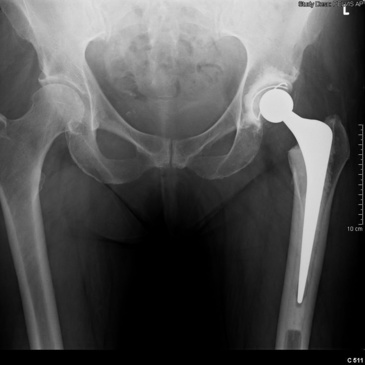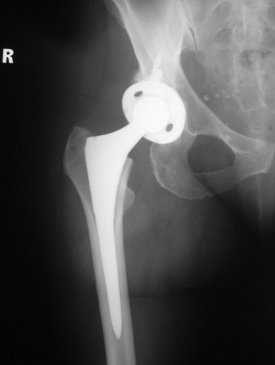Total hip replacement
Total hip arthroplasty has had consistently high success rates and high levels of patient satisfaction over the past few decades. The procedure is recognised in the medical field as the foremost quality of life improving operation. Introduced by John Charnley in the 1960s the procedure has steadily evolved with the longevity of modern hip replacements now achieving a success rate of up to 98% at 10 years.
The two principal types of total hip arthroplasty are cemented (Figure 1a) and un-cemented (Figure 1b) hip joint replacements. As the name itself suggests, bone cement is used as a grout for secure fixation of the components in cemented joint replacements. Un-cemented components rely on the bone to in-grow to achieve a secure fixation. Published studies have shown good results with both cemented and un-cemented joint replacements.
Cemented Total Hip Arthroplasty

Uncemented Total Hip Arthroplasty

Total Hip arthroplasty in Young Patients:
Young patients with arthritis expect high return from their joint replacements compared to older people. The joint replacements unlike natural joints have limited life span. Young patients have more chances in their lifetime to undergo further procedures on their hip joint. Hence the common joint replacements used now in such group of patients include, Highly Cross linked polyethylene – Ceramic and Ceramic-Ceramic joint replacements (Figure 2). The studies have reported decreased wear rate and good long-term survival with these varieties.
Ceramic-Ceramic Total Hip Arthroplasty

Frequently Asked Questions
What is total hip arthroplasty?
The procedure involves replacing the socket portion of the hip with an artificial cup and the ball portion with a metal stem (pin). The ball portion of the hip joint is excised in this procedure.
Which patients need total hip arthroplasty?
Total hip arthroplasty is recommended for patients with arthritis of the hip joint who have advanced symptoms which are interfering with the activities of daily living.
What types of total hip arthroplasty are available?
There are many types of artificial joints available, primarily differentiated by the type of fixation used to secure them in the hip and the type of bearing surface used at the joint. They can be broadly divided in t o cemented and un-cemented, depending on whether bone cement is used to secure them. Both cemented and un-cemented joint replacements can have metal-metal, metal-plastic (polyethylene) or ceramic-ceramic bearing surfaces (the two sides of the replacement which move against each other).
How long does the procedure take?
The procedure takes about 60 minutes.
How many days do I need to stay in the hospital?
You will be in the hospital for about 4-5 days. This can vary depending upon your progress while in the hospital. You will be sent home only when you are deemed fit by the multidisciplinary team looking after you.
What are the complications of such a procedure?
The complications include infection (<1%), dislocation (<2%), DVT (blood clot) and pulmonary embolism (blood clot travelling to your lungs). There are many other complications which can occur but incidences are very low. Your physician should be able to discuss these in detail.
Will I get treatment to prevent DVT (blood clots)?
You will be given injections to prevent blood clots during your stay in the hospital. You will be encouraged to mobilise early to prevent such clots. What care do you take to prevent infection? You will be given antibiotics prior to surgery. All the routine aseptic precautions will be taken to prevent infection during surgery.
Can I go back to active sports?
You can go back to non-impact activities such as cy cling, swimming, doubles tennis or golf.


 About the Glasgow Hip Clinic
About the Glasgow Hip Clinic